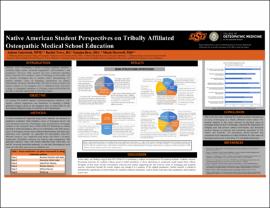| dc.contributor.author | Gatewood, Ashton | |
| dc.contributor.author | Terry, Rachel | |
| dc.contributor.author | Bray, Natasha | |
| dc.contributor.author | Hartwell, Micah | |
| dc.date.accessioned | 2023-09-12T16:44:54Z | |
| dc.date.available | 2023-09-12T16:44:54Z | |
| dc.date.issued | 2022-02-18 | |
| dc.identifier | ouhd_Gatewood_nativeamericanstudentperspectives_2022 | |
| dc.identifier.citation | Gatewood, A., Terry, R., Bray, N., & Hartwell, M. (2022, February 18). Native American student perspectives on tribally affiliated osteopathic medical school education. Poster presented at Research Days at Oklahoma State University Center for Health Sciences, Tulsa, Ok. | |
| dc.identifier.uri | https://hdl.handle.net/11244/339521 | |
| dc.description.abstract | Background: As the first tribally affiliated medical school, Oklahoma State University College of Osteopathic Medicine at Cherokee Nation (OSUCOM-CN) presents a landmark opportunity for Native American (NA) students. Little research has been conducted regarding NA students’ sense of belonging in university settings and no research investigates this in the medical school environment. Students’ sense of belonging is linked to positive academic outcomes, including higher grades, higher engagement, self- confidence, and acceptance. In addition to sense of belonging, documenting NA medical students’ perspective of culture, relationships, or closeness with their own tribe, and what it means to them to be medical students in the inaugural class of a tribally affiliated college of medicine is important. Thus, our objective is to evaluate NA students’ sense of belonging at OSUCOM-CN through a sense of belonging survey, interviews, and essay responses through this mixed-methods study. | |
| dc.description.abstract | Methods: A social constructivist approach using qualitative methods was adopted to gain an understanding of medical students’ perspectives on sense of belonging in the inaugural class at OSUCOM-CN. Data were gathered via mixed methods using a sense of belonging survey, semi-structured interviews, and essay prompts. Participants were recruited from a sampling of all medical students in the inaugural class at OSUCOM-CN identifying as tribally enrolled or of tribal descendancy alone or in combination with other race(s). Sense of belonging surveys and short-answer essays were collected via electronic and paper-copy. Interviews were audio-recorded and transcribed. (Rev, Austin, TX) Thematic analysis was conducted using Braun and Clarke’s six-phase framework. MAXQDA software was used for data categorization and management. MH generated inductive codes with themes identified from the coded data. AG and RT reviewed transcripts individually and coded the data; after which, dissolving discrepancies until 100% inter-reviewer reliability was met. | |
| dc.description.abstract | Results: Seven medical students meeting eligibility for participation criteria enrolled in this study. Data were categorized into four main themes: 1.) Psychosocial and Personal Identity: identity, personality, affiliation, or mental or physical health that affect students’ learning, engagement, and attainment, particularly stereotyping, stigma, and historical trauma. 2.) Native Culture and Heritage: family origin, heritage, participation in tribal ceremonies, oppression, stigma with specific notation of past, present, or historical oppression against engagement. 3.) Community Perception: tribe or community's change in pride or stigma over time in general or related to medicine. 4.) Tribal Affiliation: affiliation with first tribally affiliated college of medicine (TA-COM) related to the campus, faculty, other medical students, community, and the importance of being tribally affiliated. | |
| dc.description.abstract | Conclusion: This is the first study exploring NA medical students’ perspectives on sense of belonging in a tribally affiliated medical school. NA medical students in this study reported a sense of belonging related to their NA heritage, expressed the importance of bridging past and present cultural involvement, and discussed positive changes in personal and community perception of NA culture and medicine. All students placed personal and community-level importance on tribal affiliation for their sense of belonging and ability for success in becoming NA osteopathic physicians. | |
| dc.format | application/pdf | |
| dc.language | en_US | |
| dc.publisher | Oklahoma State University Center for Health Sciences | |
| dc.rights | The author(s) retain the copyright or have the right to deposit the item giving the Oklahoma State University Library a limited, non-exclusive right to share this material in its institutional repository. Contact Digital Resources and Discovery Services at lib-dls@okstate.edu or 405-744-9161 for the permission policy on the use, reproduction or distribution of this material. | |
| dc.title | Native American student perspectives on tribally affiliated osteopathic medical school education | |
| osu.filename | ouhd_Gatewood_nativeamericanstudentperspectives_2022.pdf | |
| dc.type.genre | Presentation | |
| dc.type.material | Text | |
| dc.subject.keywords | Native American | |
| dc.subject.keywords | medical education | |
| dc.subject.keywords | Cherokee Nation | |
